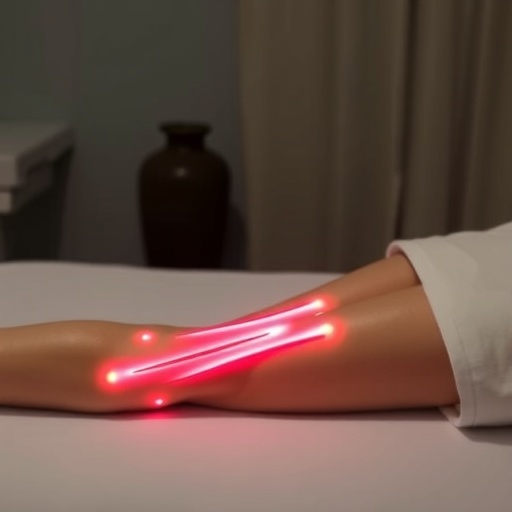Chemotherapy-induced peripheral neuropathy (CIPN) remains one of the most challenging side effects faced by breast cancer patients undergoing taxane-based chemotherapy. Characterized by numbness, tingling, and pain in extremities, CIPN can severely diminish quality of life and complicate treatment regimens. In a groundbreaking advancement, recent research published in BMC Cancer explores a novel preventive strategy: compression therapy utilizing standard surgical gloves and stockings. This approach, while promising, has raised questions regarding patient comfort and practical usability, which are critical factors for long-term adherence in clinical settings.
The debilitating nature of CIPN stems primarily from the neurotoxic effects of taxane agents, which disrupt microtubule function within peripheral nerves. Despite numerous pharmacological attempts to mitigate these effects, effective prevention has remained elusive. Compression therapy has emerged as a non-pharmacologic intervention aimed at reducing peripheral blood flow during chemotherapy, thereby limiting drug delivery to susceptible nerve tissues. Yet, translating this physiological rationale into a patient-friendly application has posed significant challenges.
In an insightful sub-analysis of a Phase I trial, researchers focused on patient-reported discomfort and usability of compression therapy, employing double-layered surgical gloves and stockings applied during taxane chemotherapy sessions. This open-label study enrolled ten breast cancer patients undergoing neoadjuvant or adjuvant treatment, collecting subjective data via structured questionnaires designed to assess discomfort, pressure sensations, pain, and itchiness in both hands and feet. The trial illuminated key insights into the patient experience often overlooked in clinical efficacy studies.
Quantitative findings revealed that patients generally tolerated the compression garments well. Mean discomfort scores remained notably low, with hands averaging 1.8 and feet 2.2 on discomfort scales where lower values indicate better tolerance. Importantly, no instances of pain were reported during wear, signaling a favorable safety profile of this intervention. Perceived pressure ratings showed slight to mild intensities, with calves experiencing the highest levels of pressure compared to toes and fingertips, suggesting anatomical variances in compression effects.
Despite the positive comfort profile, free-text patient feedback highlighted practical obstacles. Application and removal of double-layered compression garments presented substantial difficulties for many participants. Challenges such as limited dexterity, time consumption, and fit issues emerged as significant barriers, overshadowing physical discomfort as the predominant factor that could impede adherence to therapy protocols. This underlines the crucial need to prioritize garment design improvements for real-world usability.
Moreover, statistical analyses in the study did not demonstrate significant correlations between discomfort and other variables such as pain or itch. However, a discernible trend suggested that higher discomfort scores were weakly associated with increased reports of pain, inviting further research with larger cohorts to explore this relationship more robustly. These findings underscore the complex interplay between physiological response and subjective perception in compression therapy.
The implications of this research extend beyond the trial’s immediate scope. Compression therapy, when optimized for user-friendliness and tailored fit, could revolutionize CIPN management by offering a non-invasive, low-risk preventive option. The minimal discomfort reported supports the therapy’s viability, but overcoming usability hurdles remains paramount. This will require engineering advances in material science and ergonomic design, potentially integrating feedback from patients to enhance adherence.
Challenges identified in application mechanics emphasize the necessity for innovation in compression garment technology. Future iterations might involve adaptive fabrics with improved elasticity, simplified donning methods, or modular designs that accommodate varying limb sizes and shapes. Such enhancements could substantially reduce the patient burden, enabling consistent use throughout chemotherapy cycles, thereby maximizing the preventative potential against neuropathy.
This study also prompts reconsideration of clinical protocols surrounding CIPN prevention. Incorporating patient-centered outcome measures, such as comfort and usability, should become standard in evaluating new therapeutic strategies. The integration of subjective experience alongside objective efficacy metrics ensures that interventions are not only clinically effective but also practically implementable in diverse patient populations.
While preliminary, the findings from this sub-analysis establish a strong foundation for larger-scale trials. Expanding sample sizes and exploring different chemotherapy regimens will help validate the generalizability of compression therapy benefits. Additionally, longer follow-up periods may provide insights into sustained usability and potential cumulative effects on CIPN incidence and severity.
Importantly, this research aligns with the broader movement towards personalized medicine in oncology supportive care. Patient-reported outcomes empower clinicians and researchers to tailor interventions that respect individual tolerances and preferences, ultimately enhancing therapeutic adherence and improving overall cancer treatment experiences.
Beyond breast cancer, the concept of compression therapy could extend to other malignancies treated with neurotoxic chemotherapy agents. Its non-pharmacological nature implies fewer drug interactions and side effects, widening its appeal and applicability. However, thorough investigations into disease-specific factors influencing compression efficacy and tolerance will be necessary.
In conclusion, the study enriches our understanding of compression therapy’s role in preventing chemotherapy-induced peripheral neuropathy. While safety and minimal discomfort are encouraging, the practical dimension of therapy delivery demands innovation and patient-focused refinement. As oncology care advances, integrating such multidisciplinary insights will be crucial to translating scientific innovations into life-enhancing treatments for cancer patients worldwide.
Subject of Research: Chemotherapy-induced peripheral neuropathy prevention in breast cancer patients through compression therapy.
Article Title: Refining compression therapy for the prevention of chemotherapy-induced peripheral neuropathy in breast cancer patients: a sub-analysis of patient-reported discomfort and usability.
Article References:
Okazaki, M., Ueda, A., Iguchi-Manaka, A. et al. Refining compression therapy for the prevention of chemotherapy-induced peripheral neuropathy in breast cancer patients: a sub-analysis of patient-reported discomfort and usability. BMC Cancer 25, 1567 (2025). https://doi.org/10.1186/s12885-025-14921-3
Image Credits: Scienmag.com




